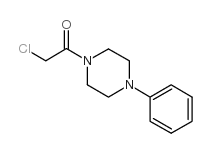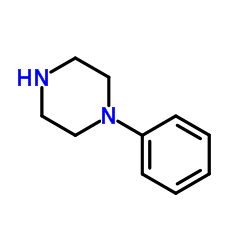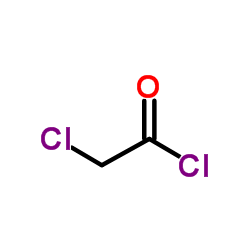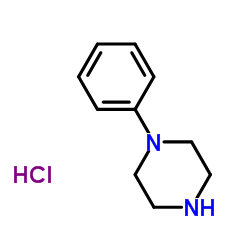14761-39-8
| Name | 2-chloro-1-(4-phenylpiperazin-1-yl)ethanone |
|---|---|
| Synonyms |
4-phenyl-1-chloroacetyl piperazine
1-phenyl-4-chloroacetyl-piperazine |
| Density | 1.221g/cm3 |
|---|---|
| Boiling Point | 404.7ºC at 760mmHg |
| Melting Point | 71-73ºC |
| Molecular Formula | C12H15ClN2O |
| Molecular Weight | 238.71300 |
| Flash Point | 198.5ºC |
| Exact Mass | 238.08700 |
| PSA | 23.55000 |
| LogP | 1.57690 |
| Vapour Pressure | 9.29E-07mmHg at 25°C |
| Index of Refraction | 1.569 |
Synonym: Section 2 - COMPOSITION, INFORMATION ON INGREDIENTS
Risk Phrases: 20/21/22 34 Section 3 - HAZARDS IDENTIFICATION EMERGENCY OVERVIEW
Harmful by inhalation, in contact with skin and if swallowed. Causes burns. Potential Health Effects Eye: Causes eye burns. Skin: Harmful if absorbed through the skin. Causes skin burns. Ingestion: Harmful if swallowed. Causes gastrointestinal tract burns. Inhalation: Harmful if inhaled. Causes chemical burns to the respiratory tract. Chronic: Not available. Section 4 - FIRST AID MEASURES Eyes: Immediately flush eyes with plenty of water for at least 15 minutes, occasionally lifting the upper and lower eyelids. Get medical aid immediately. Skin: Get medical aid immediately. Immediately flush skin with plenty of water for at least 15 minutes while removing contaminated clothing and shoes. Ingestion: Do not induce vomiting. Get medical aid immediately. Inhalation: Get medical aid immediately. Remove from exposure and move to fresh air immediately. If not breathing, give artificial respiration. If breathing is difficult, give oxygen. Notes to Physician: Treat symptomatically and supportively. Section 5 - FIRE FIGHTING MEASURES General Information: As in any fire, wear a self-contained breathing apparatus in pressure-demand, MSHA/NIOSH (approved or equivalent), and full protective gear. Extinguishing Media: Use foam, dry chemical, or carbon dioxide. Section 6 - ACCIDENTAL RELEASE MEASURES General Information: Use proper personal protective equipment as indicated in Section 8. Spills/Leaks: Vacuum or sweep up material and place into a suitable disposal container. Section 7 - HANDLING and STORAGE Handling: Do not breathe dust, vapor, mist, or gas. Do not get in eyes, on skin, or on clothing. Use only in a chemical fume hood. Storage: Store in a cool, dry place. Store in a tightly closed container. Corrosives area. Section 8 - EXPOSURE CONTROLS, PERSONAL PROTECTION Engineering Controls: Facilities storing or utilizing this material should be equipped with an eyewash facility and a safety shower. Use adequate ventilation to keep airborne concentrations low. Exposure Limits CAS# 14761-39-8: Personal Protective Equipment Eyes: Not available. Skin: Wear appropriate protective gloves to prevent skin exposure. Clothing: Wear appropriate protective clothing to prevent skin exposure. Respirators: Follow the OSHA respirator regulations found in 29 CFR 1910.134 or European Standard EN 149. Use a NIOSH/MSHA or European Standard EN 149 approved respirator if exposure limits are exceeded or if irritation or other symptoms are experienced. Section 9 - PHYSICAL AND CHEMICAL PROPERTIES Physical State: Solid Color: Not available. Odor: Not available. pH: Not available. Vapor Pressure: Not available. Viscosity: Not available. Boiling Point: Not available. Freezing/Melting Point: 77 - 79 deg C Autoignition Temperature: Not available. Flash Point: Not available. Explosion Limits, lower: Not available. Explosion Limits, upper: Not available. Decomposition Temperature: Solubility in water: Specific Gravity/Density: Molecular Formula: C12H15ClN2O Molecular Weight: 238.72 Section 10 - STABILITY AND REACTIVITY Chemical Stability: Not available. Conditions to Avoid: Incompatible materials. Incompatibilities with Other Materials: Strong oxidizing agents. Hazardous Decomposition Products: Hydrogen chloride, chlorine, carbon monoxide, oxides of nitrogen, carbon dioxide. Hazardous Polymerization: Has not been reported Section 11 - TOXICOLOGICAL INFORMATION RTECS#: CAS# 14761-39-8 unlisted. LD50/LC50: Not available. Carcinogenicity: 2-Chloro-1-(4-phenylpiperazino)ethan-1-one - Not listed by ACGIH, IARC, or NTP. Section 12 - ECOLOGICAL INFORMATION Section 13 - DISPOSAL CONSIDERATIONS Dispose of in a manner consistent with federal, state, and local regulations. Section 14 - TRANSPORT INFORMATION IATA Shipping Name: CORROSIVE SOLID, TOXIC, N.O.S.* Hazard Class: 8 (6.1) UN Number: 2923 Packing Group: III IMO Shipping Name: CORROSIVE SOLID, TOXIC, N.O.S. Hazard Class: 8 (6.1) UN Number: 2923 Packing Group: III RID/ADR Shipping Name: CORROSIVE SOLID, TOXIC, N.O.S. Hazard Class: 8 UN Number: 2923 Packing group: III Section 15 - REGULATORY INFORMATION European/International Regulations European Labeling in Accordance with EC Directives Hazard Symbols: C Risk Phrases: R 20/21/22 Harmful by inhalation, in contact with skin and if swallowed. R 34 Causes burns. Safety Phrases: S 26 In case of contact with eyes, rinse immediately with plenty of water and seek medical advice. S 36/37/39 Wear suitable protective clothing, gloves and eye/face protection. S 45 In case of accident or if you feel unwell, seek medical advice immediately (show the label where possible). WGK (Water Danger/Protection) CAS# 14761-39-8: No information available. Canada None of the chemicals in this product are listed on the DSL/NDSL list. CAS# 14761-39-8 is not listed on Canada's Ingredient Disclosure List. US FEDERAL TSCA CAS# 14761-39-8 is not listed on the TSCA inventory. It is for research and development use only. SECTION 16 - ADDITIONAL INFORMATION N/A |
| Hazard Codes | C:Corrosive |
|---|---|
| Risk Phrases | R20/21/22;R34 |
| Safety Phrases | S26-S36/37/39-S45 |
| HS Code | 2933599090 |
|
~99% 
14761-39-8 |
| Literature: NAM, Ghilsoo; Choi, Kyung Il; Kim, Hye Ran; Seo, Seon Hee; Kim, Yoon Jee; Shin, Hee Sup; Kim, Dong Jin; Pae, Ae Nim; Chung, Hye Jin; Choo, Hyunah; Rhim, Hyewhon; Cho, Yong Seo; Roh, Eun Joo; Keum, Gyo Chang; Choi, Kee Hyun; Shin, Kye Jung; Hahn, Hoh Gyu; Cheong, Chan Seong; Lee, Jae Kyun; Nam, Kee Dal; Kang, Yong Koo; Kim, Youngsoo; Park, Woong Seo; Kim, Eunice Eun-Kyeong; Kim, Key-Sun; Chung, Hesson; Shin, Dong Yun; Song, Chi man Patent: US2010/94006 A1, 2010 ; Location in patent: Page/Page column 10 ; |
|
~91% 
14761-39-8 |
| Literature: Zhang, Xiaoru; Yang, Xiaohui; Zhang, Shusheng Synthetic Communications, 2009 , vol. 39, # 5 p. 830 - 844 |
| HS Code | 2933599090 |
|---|---|
| Summary | 2933599090. other compounds containing a pyrimidine ring (whether or not hydrogenated) or piperazine ring in the structure. VAT:17.0%. Tax rebate rate:13.0%. . MFN tariff:6.5%. General tariff:20.0% |


